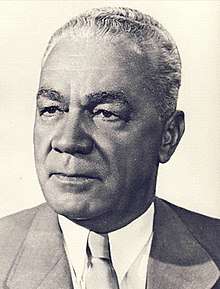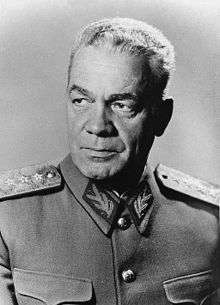Emil Bodnăraș


Emil Bodnăraș (10 February 1904 – 24 January 1976) was an influential Romanian Communist politician, an army officer, and a Soviet agent. He was involved in many of the events of Communist Romania, thus making him a complex figure of Romanian Communism.[1]
Early life
Bodnăraș was born to a Ukrainian father and a German mother in 1904, in Iaslovăț, Suceava County, Bukovina, then under Austrian rule.[1] His military career as an artillery officer was interrupted by a conflict with a member of the Romanian Royal House. He was transferred to a garrison in Bessarabia where he was contacted by Communist elements, became a Soviet spy and defected to the USSR in 1931.[2] He returned to Romania in 1935 and fulfilled different special missions for Soviet military intelligence. Caught by accident, Bodnăraș was sentenced to ten years in prison. Imprisoned at Brașov, Doftana and Caransebeș, he entered the Romanian Communist Party in 1940 becoming a key figure in Gheorghe Gheorghiu-Dej's faction. He was released in 1942.[3]
1944–1947
In 1944, Bodnăraș, together with Iosif Rangheț and Constantin Pîrvulescu, was a key participant in the political elimination and physical isolation of Ștefan Foriș, the General Secretary of the Party. The three of them dominated the leadership of the Party until Dej's escape from prison in August of the same year. After the massive bombing of Bucharest on 4 April 1944, Bodnăraș and Rangheț captured Foriș and forced him to sign his deposition at gunpoint.[4]
Bodnăraș participated in the 23 August 1944 coup led by King Michael against the government of Ion Antonescu. He organized underground paramilitary units[5] and together with Col. Dumitru Dămăceanu coordinated the weakening of a segment of the Moldavian front called "Poarta Iașiului" against the Soviet offensive of August 1944.[6] He was part of a group of communists who took custody of Ion Antonescu after his arrest, and took him and Mihai Antonescu to a safe house, before handing the two prisoners to Soviet troops.[5]
He became a member of the Politburo.[7] During March 1945 and November 1947 he became a secretary-general of the "Council of Ministers"' presidency, being in charge of secret intelligence services.[8] From this position he was one of the orchestrators of the electoral fraud from 1946[9] and of the Tămădău Affair.[7]
His enormous influence was due to permanent direct contact with the Soviet secret services (he was reporting on each of the Romanian Communist Party leaders, as revealed later in the case of Ana Pauker).[1]
Under Gheorghiu-Dej
He held several important positions under Gheorghiu-Dej: minister of defense, army general, vice premier.[1] On 27 December 1947 he became Minister of Defense, taking over the position previously held by Mihail Lascăr. He held this office until 3 October 1955, while in 1956 he became Minister of Transportation.[10] During his tenure, the Sovietization of the Romanian Army occurred.[11] Bodnăraș sent several Romanian Communists to Moscow to be trained in a special military school, among them the young Nicolae Ceaușescu, who became a close and zealous collaborator and was appointed general and political commissar of the military forces.[12]
He remained one of Gheorghiu-Dej's supporters until Dej's death, and he resisted the restructurations of the Party proposed by Iosif Chișinevschi and Miron Constantinescu.[13]
During the Hungarian Revolution of 1956, Bodnăraș led a body authorized to intervene and even to open fire in crisis situations. In November, together with Gheorghiu-Dej, he also led the Romanian delegation to Hungary to discuss with János Kádár and support the suppression of the Hungarian revolution.[14]
It seems he also had a key role in influencing Nikita Khrushchev's decision to withdraw the Red Army from Romania in 1958.[5][15] According to Khrushchev's memoirs, Bodnăraș proposed the withdrawal of the troops at a time that the Soviet leaders was not considering it and expected the troops to remain until the end of the Cold War.[16]
After the death of Gheorghiu-Dej in March 1965, Bodnăraș, as one of the most influential members of the Politburo, decided to support Ceaușescu instead of Gheorghe Apostol or Alexandru Drăghici, thus facilitating Ceaușescu's ascension to the position of General Secretary of the Party.[17]
Under Ceaușescu
Bodnăraș transferred his loyalty to Ceaușescu,[18] receiving in exchange the position of vice president of the State Council, and he remained a member of the Communist élite until his death.[19] The town of Milişăuţi was named to Emil Bodnăraș from 7 September 1976 to 20 May 1996.
Notes
- 1 2 3 4 Final Report, p. 646
- ↑ Final Report, p. 43, 646
- ↑ Final Report, p. 43, 646; Betea
- ↑ Final Report, p. 43, 646; Arvatu
- 1 2 3 Arachelian
- ↑ Vasile
- 1 2 Final Report, p. 40
- ↑ Final Report, p. 38
- ↑ Final Report, p. 131
- ↑ Final Report, p. 43 n. 32
- ↑ Oroian; Vankovska, Wiberg, p. 115; Final Report, p. 125
- ↑ Pacepa, p. 357-358
- ↑ Final Report, p. 64, 70, 73
- ↑ Final Report, p. 77-78
- ↑ Final Report, p. 43 n. 32, p. 205
- ↑ Nikita Sergeevich Khrushchev, Sergeĭ Khrushchev. Memoirs of Nikita Khrushchev: Statesman, 1953–1964, Pennsylvania State University Press, 2007, page 706, ISBN 0-271-02935-8
- ↑ Final Report, p. 96
- ↑ Pacepa, p. 130-131
- ↑ Final Report, p. 100, 646
References
| Wikimedia Commons has media related to Emil Bodnăraş. |
- (in Romanian) Final Report of the Presidential Commission for the Study of the Communist Dictatorship in Romania
- (in Romanian) Lavinia Betea, "Bodnăraș – cetățean sovietic" ("Bodnăraș – Soviet citizen") in Jurnalul Național, October 4, 2005
- (in Romanian) Cristina Arvatu, "Răfuială cu șeful in stil gangsteresc" ("Settling accounts with the boss in gangster style"), in Jurnalul Național, October 5, 2005
- (in Romanian) Lavinia Betea, "'Sforarul' Bodnăraș și lecția crimei politice" ("The Schemer Bodnăraș and the Lesson of Political Crime"), in Adevărul, August 22, 2011
- (in Romanian) Vartan Arachelian, "Falsificatorii" ("The deceivers"), in Ziua, August 23, 2005
- (in Romanian) Miron Vasile, "Bodnăraș uneltește, la Palat, deschiderea frontului prin 'Poarta Iașiului'", in Historia, August 2004
- (in Romanian) Teofil Oroian, "Scurta cronica a consilierilor (1948/1949 – 1959/1960)" ("Soviet counsellors in the Romanian army: A brief historical perspective"), in Dosarele Istoriei, December 2003
- Biljana Vankovska, Håkan Wiberg, Between past and future: civil-military relations in the post-communist Balkans, I. B. Tauris, 2003, ISBN 1-86064-624-7
- Ion Mihai Pacepa, Red Horizons: The True Story of Nicolae and Elena Ceauşescus' Crimes, Lifestyle, and Corruption, Regnery Publishing, 1990, ISBN 0-89526-746-2
- (in Romanian) Cristina Scorțariu, "Repunerea pe soclu a lui Bodnăraș aduce nemulțumiri în rândul istoricilor", in Informația, August 13, 2003
- (in Romanian) Minister of Defense's photo album – Bodnăraș Emil